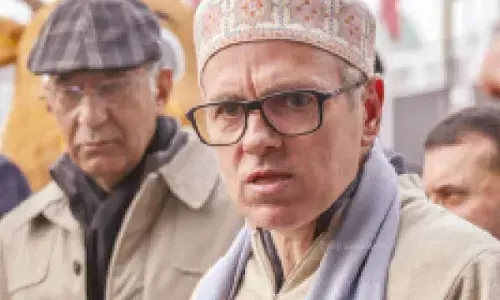China uses information weapons before war

Over a period, say a decade or so, China has emerged as a pivotal player in every arena of international competition. This period has also impacted the Chinese leaders significantly. One could say that pro-democracy movement in 1989 and the break-up of the Soviet Union had alarmed the leadership of the country as never before. Its fears only got worse when the allies became triumphal in the Gulf W
Over a period, say a decade or so, China has emerged as a pivotal player in every arena of international competition. This period has also impacted the Chinese leaders significantly. One could say that pro-democracy movement in 1989 and the break-up of the Soviet Union had alarmed the leadership of the country as never before. Its fears only got worse when the allies became triumphal in the Gulf War.
Observers have been zeroing on Hong Kong example to reiterate how China could behave with Taiwan in future in seeking reunification. The increased military activities in the South China Sea or its ‘diplomacy’ of claiming land including using commerce and investments in other parts of the world are all indicative of its hunger for land.
In the process, it has reshaped its military strategy significantly and without a proper understanding of the same, it would be difficult to understand what China’s intentions are.
Doklam stand-off and the subsequent propaganda war that the Chinese machinery has unleashed would also not be understood unless its strategy is unveiled.
In building a “Comprehensive National Strength” by enhancing China’s international standing, improving weapons and telecommunications and promoting continued economic development all the while managing internal stability, the Chinese leadership does not spare anything. If one is to seek morals, ethics, scruples etc., or expect any of these qualities in its actions, it would be a mistake.
Let us revisit China’s “Three Warfares” doctrine adopted in 2003 by the Central Committee of the Communist Party for the PLA. This is in essence the PLA’s strategy since then and it has been able to utilise the full range of it ever since in waging a psychological war fare using media effectively and also laying legal foundations for its arguments. This is essentially to undermine not just international institutions, but also change borders and mislead and subvert global media and influence public opinion across the borders without having to fire a single bullet.
Whenever China stakes a claim on any territory, it always does so with an eye on the invaluable geostrategic value of the area or its mineral wealth and potential. Look at South China Sea, which is home to $5 trillion worth of shipping and energy reserves. The world is aware that the Chinese claims here are in conflict with those of the smaller neighbours, Philippines and Vietnam and in contravention with the UN Convention on the Law of the Sea (UNCLOS) since 1994.
China began dredging the seabed and transformed the rocks and reefs into artificial islands to lay legal claims to the same. Thus, they not only claim these islands as their own, but then lay territorial claim on the 12-nautical mile zone around them and also seek 200 nautical miles of Exclusive Economic Zone. To back up this “Lawfare” China uses its ‘Mindfare’ threatening to use sanctions, import restrictions and by harassing the fishing and coastguard vessels of neighbours in the waters.
Media is extensively used in maligning the neighbours and to “blame them for the incursions into Chinese territory”. In fact, when Chinese stock markets crashed in the 1997 financial crisis, the Chinese think tanks blamed the Americans for the same.
Unlike India, China uses its information weapons effectively in gaining advantages without declaration of war. Even in the case of Doklam, China invaded Bhutanese territory, started laying roads towards the crucial Chicken Neck area claiming false documentary evidence and blaming India as the aggressor for preventing threat to India’s sovereignty. (The Russians are also adept in the game and the silent takeover of Crimea proves it).
The primary mission of the PLA is to ‘disorganise’ the functioning of military-political leadership, troops and populations with the use of modern information technologies and means because information weapons provide states with a method of gaining advantages without “declaration of war”.
Generally, for any other country, information warfare is a part of response to a conflict situation. It is always limited or specific in time and defined in goals. That is because war is the opposite of peace and in the latter times, it is business as usual as one does not need to fight the enemy.
However, for China it is a continuous process. Psychological war against opponents, real or perceived, is perennial and the war itself open-ended and widely applicable as experts believe.
Herein, China wages a war on information as well as disseminates “weaponised information” to attack India. Taking teams of journalists to display its military potential and “exchanging views” with embassies that could work against the adversaries are all part of the strategy.
There is no doubt that Chinese leadership has learnt its lessons from the pre-modern days itself as it relies heavily on the “Art of War” of Sun Tzu, a 5th century nobleman who lived in the present Shandong province of China.
China has adapted the warfare fully. There are four stages to this too: “Attacking the enemy’s mind (strategy), attacking his alliances next, attacking his troops is next and attacking his fortified cities is the worst”, This is its traditional origin of psychological warfare.
The foundation for the 2003 document of PLA was perhaps laid in 1994 itself when Liu Yinchao, PLA 65th Group Army Commander termed psychological warfare as the fourth kind of warfare after, land, air and sea warfare.
He wrote in Liberation Army Daily then: To instil fear and awe in the minds of enemies, to create panic among the adversary civilian population, to obtain the sympathy of neutral States and attacking and influencing the target’s policy makers causing their position to waver and make them choose a policy which is in fact disadvantageous to themselves are key to this fourth warfare.
China links all its interests, economic, military and diplomatic objectives to achieve its goal of “Comprehensive National Strength”. It is doing the same now. If there is a difference now, it is in its increased aggressiveness and its perception that India is weak by all means, particularly, its political system. It feels it could manipulate the politicians and power centres in India so that they could question their own government and weaken its resolve in defending the country’s territory.
Whether this means limited war, a short-term war or a long term one, it wants to convey to us that it could be a “two and half front war” in every sense.
India is an easy target for China politically even if it cannot inflict a crushing damage on its military because of the whimsical ways of our politicians and their venomous ways of attacking the opponents. Rahul Gandhi recently claimed that it was his duty to be informed and hence had gone to the Chinese Embassy. A question remains to be answered here - has he been informed by the Chinese Ambassador suitably? And if so - What is Rahul’s take on Doklam?
In essence, China is attempting to take advantage of prior peacetime preparation of this perceptual battlefield to establish favourable conditions for going on the offensive to seize the initiative. It does not mean that it would stop at that. China is using this warfare against India now to prepare its people for the eventuality of a warfare with India. Since this is a dimension of strategic competition in which China has already demonstrated its efficacy of its efforts, understanding the ‘three warfares’ would be beneficial to countries like India.




















